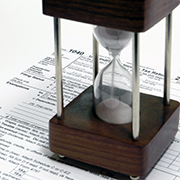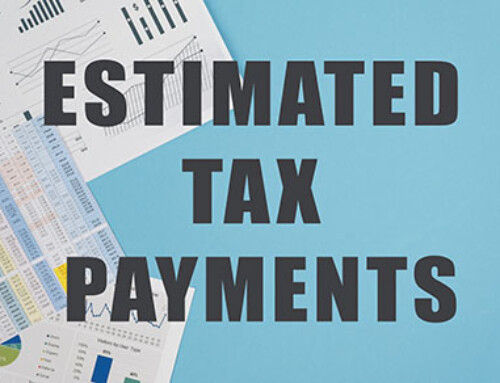The Tax Cuts and Jobs Act (TCJA) made sweeping changes to the federal tax rules for individual taxpayers. Many of these provisions are scheduled to expire at the end of 2025. But there’s a chance that some (or all) of the provisions could be extended or made permanent with legislation in the future. This uncertainty complicates tax planning for many people. Here’s an overview of some key provisions that may soon come to an end and how their expiration could affect your personal tax situation.
Reduced Tax Rates for Ordinary Income and Short-Term Capital Gains
For 2018 through 2025, the TCJA contains seven tax rate brackets as under prior law, but five of the rates are temporarily lower than they were under prior law. The 2024 rate brackets for ordinary income and net short-term capital gains are as follows:
2024 Federal Tax Rates on Ordinary Income and Net Short-Term Capital Gains
| Tax Rates | Single | Married Joint Filers | Head of Household |
| 10% | $0 – $11,600 | $0 – $23,200 | $0 – $16,550 |
| 12% | $11,601 – $47,150 | $23,201 – $94,300 | $16,551 – $63,100 |
| 22% | $47,151 – $100,525 | $94,301 – $201,050 | $63,101 – $100,500 |
| 24% | $100,526 – $191,950 | $201,051 – $383,900 | $100,501 – $191,950 |
| 32% | $191,951 – $243,725 | $383,901 – $487,450 | $191,951 – $243,700 |
| 35% | $243,726 – $609,350 | $487,451 – $731,200 | $243,701 – $609,350 |
| 37% | $609,351 and up | $731,201 and up | $609,351 and up |
If Congress allows this TCJA provision to expire, the rates and brackets that were in place for 2017 (with cumulative inflation adjustments for the bracket thresholds) are scheduled to return starting in 2026. Importantly, the top rate bracket would move from the current 37% to 39.6%.
Favorable Tax Rates for Capital Gains and Qualified Dividends
The TCJA retained the 0%, 15% and 20% tax rates on net long-term capital gains (LTCGs) and qualified dividends. Here are the 2024 federal rate brackets for net LTCGs and qualified dividends, based on taxable income:
2024 Federal Tax Rates on Net LTCGs and Qualified Dividends
| LTCG tax rate | Single | Married filing jointly | Head of household |
| 0% | $0–$47,025 | $0–$94,050 | $0–$63,000 |
| 15% | $47,026–$518,900 | $94,051–$583,750 | $63,001–$551,350 |
| 20% | $518,901 and up | $583,751 and up | $551,351 and up |
If Congress allows this provision to expire, the rates and brackets that were in place for 2017 (with cumulative inflation adjustments for the bracket thresholds) are scheduled to return starting in 2026. If Congress doesn’t extend this provision or make it permanent, the threshold for the 20% rate on net LTCGs and dividends for 2026 will be the same as the threshold for the top rate for ordinary income.
AMT Changes
The alternative minimum tax (AMT) still exists for individuals under the TCJA. However, with the favorable TCJA changes, the AMT hits fewer individuals for 2018 through 2025. For 2024, the top 28% AMT rate starts when AMT income exceeds the following thresholds:
- $232,600 for single filers, married joint filers and heads of households, and
- $116,300 for married separate filers.
Under the AMT rules, you’re allowed an inflation-adjusted AMT exemption that’s deducted in calculating AMT income. The TCJA significantly increased the exemption amounts for 2018 through 2025. The exemption is phased out when your AMT income exceeds the applicable threshold. If your AMT bill for the year exceeds your regular tax bill, you owe the higher AMT amount.
Here are the AMT exemption amounts and phaseout thresholds for 2024:
2024 AMT Exemptions
| Single or head of household | Married filing jointly | |
| Amount | $85,700 | $133,300 |
| Phaseout | $609,350–$952,150 | $1,218,700–$1,751,900 |
Important: The exemption is completely phased out if AMT income exceeds the top of the applicable range.
If Congress allows this TCJA provision to expire, the less-favorable rules that were in place for 2017 (with cumulative inflation adjustments) are scheduled to return starting in 2026.
Increased Standard Deductions
For 2018 through 2025, the TCJA nearly doubled the standard deduction amounts. For 2024, the inflation-adjusted standard deduction amounts are as follows:
- $14,600 for single filers,
- $29,200 for married joint filers, and
- $21,900 for heads of households.
Important: Additional amounts apply for elderly and blind individuals.
If Congress allows this TCJA provision to expire, the much lower standard deduction amounts that were in place for 2017 (with cumulative inflation adjustments) are scheduled to return starting in 2026.
Suspended Personal and Dependent Exemptions
For 2018 through 2025, the TCJA suspended personal and dependent exemption deductions. If these deductions were still allowed, they would have been $5,050 each for 2024.
If Congress allows this TCJA provision to expire, the personal and dependent exemption deduction that was in place for 2017 (with a cumulative inflation adjustment) is scheduled to return starting in 2026.
Expanded Child and Dependent Tax Credits
As a trade-off for suspended dependent exemptions, the TCJA increases the maximum child credit for 2018 through 2025 to $2,000 per qualifying child (up from $1,000 under prior law). For 2024, up to $1,700 of the child credit can be refundable. This means taxpayers can collect it even if they don’t owe any federal income tax. Additionally, for 2018 through 2025, the income levels at which the child tax credit is phased out were significantly increased, so many more families with children under 17 qualify for the credit.
Through 2025, the TCJA also established a new $500 credit for eligible dependents who aren’t qualified children.
If Congress allows these TCJA provisions to expire, the less favorable rules for the child credit that were in place for 2017 are scheduled to return — and the $500 dependent tax credit will disappear — starting in 2026.
Limitation on State and Local Tax Deductions
Before the TCJA, you could claim itemized deductions for an unlimited amount of personal (nonbusiness) state and local income and property taxes. Alternatively, you had the option of forgoing any deduction for state and local income taxes and instead deducting state and local general sales taxes.
For 2018 through 2025, the TCJA limits itemized deductions for personal state and local income and property taxes to a combined total of $10,000 ($5,000 for married couples who file separately). For 2018 through 2025, foreign real property taxes aren’t deductible. However, you can still opt to deduct state and local general sales taxes instead of state and local income taxes, subject to the $10,000 limitation ($5,000 for married couples who file separately).
If Congress allows this TCJA provision to expire, the more favorable rules for itemized personal state and local income tax that were in place for 2017 are scheduled to return starting in 2026.
Reduced Thresholds for Home Mortgage Interest Deductions
For 2018 through 2025, the TCJA allows you to claim itemized deductions for qualified home mortgage interest on up to $750,000 of home acquisition mortgage debt incurred to buy or improve a first or second residence ($375,000 for married couples who file separately). Under prior law, the limit on mortgage debt was $1 million ($500,000 for married couples who file separately).
In addition, for 2018 through 2025, the TCJA suspends the provision that previously allowed interest deductions on up to $100,000 of home equity loan balances.
If Congress allows these TCJA provisions to expire, the rules for itemized home mortgage interest deductions that were in place for 2017 are scheduled to return starting in 2026.
Other Suspended Itemized Deductions
For 2018 through 2025, the TCJA suspended itemized deductions for the following items:
- Miscellaneous expenses, such as investment expenses and unreimbursed employee business expenses, and
- Personal casualty and theft losses, except for losses incurred in federally declared disasters.
Important: The TCJA allows personal casualty and theft losses to be claimed, up to the amount of the taxpayer’s personal casualty gains. Gains occur when insurance proceeds exceed the basis of the damaged or destroyed property.
Under prior law, miscellaneous itemized deductions were subject to the 2%-of-AGI deduction threshold, and personal casualty and theft losses were fully deductible if they exceeded 10% of your AGI.
If Congress allows these TCJA provisions to expire, the more favorable rules for these itemized deductions that were in place for 2017 are scheduled to return starting in 2026.
Itemized Deduction Phaseout Rule
Before the TCJA, higher-income individuals were subject to a phaseout rule that could eliminate up to 80% of the most popular itemized deductions (including home mortgage interest, property taxes, and charitable donations). The TCJA suspends the itemized deduction phaseout rule for 2018 through 2025.
If Congress allows this TCJA provision to expire, the unfavorable phaseout rule that was in place for 2017 is scheduled to return starting in 2026.
Unfavorable Changes to the Tax Treatment of Moving Expenses
For 2018 through 2025, the TCJA generally suspends deductions for moving expenses. Before the TCJA, many taxpayers qualified for above-the-line deductions for allowable moving expenses that weren’t reimbursed by their employers. This means they didn’t have to itemize to claim the write-off.
In addition, for 2018 through 2025, the TCJA suspends the tax-free treatment for employer-paid moving expenses. Currently, employer payments and reimbursements must be reported on employees’ W-2 forms and included in their taxable income. Under prior law, employer payments and reimbursements for eligible moving expenses were tax-free.
Important: Exceptions to these provisions are allowed for active-duty members of the Armed Forces.
If Congress allows these TCJA provisions to expire, the more favorable treatment of moving expenses that was in place for 2017 is scheduled to return starting in 2026.
Limitations for Charitable Deductions
The TCJA provisions for itemized charitable contribution deductions are a mixed bag. On the plus side, under the TCJA, the AGI limit on the deduction for cash contributions to public charities and certain private foundations was increased from 50% to 60% for 2018 through 2025. Deductions that are disallowed by this limit can generally be carried forward for five years.
If Congress allows this TCJA provision to expire, the less favorable limit that was in place for 2017 is scheduled to return starting in 2026.
Conversely, itemized charitable contribution deductions may be somewhat harder to come by for certain donors under the TCJA. That’s because to deliver any tax-saving benefit, a taxpayer’s total itemizable deductions, including charitable donations, must exceed the applicable standard deduction. The TCJA greatly increased standard deduction amounts for 2018 through 2025, resulting in fewer people itemizing. However, unless Congress extends the increased standard deduction amounts or makes them permanent, they’ll return to 2017 levels (with cumulative inflation adjustments) starting in 2026. If this provision expires, more individuals will be able to claim itemized deductions for charitable contributions.
Important: Starting in 2018, the TCJA also permanently disallowed deductions for contributions paid to colleges in exchange for athletic event tickets.
Limitation on Deductions for Professional Gamblers
For 2018 through 2025, the TCJA stipulates that combined deductions for a professional gambler’s out-of-pocket gambling-related expenses and gambling losses incurred during the year are limited to gambling winnings for the year. Under prior law, a professional gambler could deduct out-of-pocket gambling-related expenses as a Schedule C business expense without regard to the gambling winnings limitation. Only deductions for actual gambling losses (wagering losses) were limited to gambling winnings.
Important: Amateur gamblers have never been allowed to deduct out-of-pocket gambling-related expenses. That’s still true under the TCJA.
If Congress allows this TCJA provision to expire, the more favorable rules for professional gamblers that were in place for 2017 are scheduled to return starting in 2026.
Favorable Estate and Gift Tax Rules
The TCJA retains the flat 40% tax rate on estates and gifts that exceed the unified federal estate and gift tax exemption. But it increases the exemption from $5 million to $10 million, indexed annually for inflation. For 2024, the exemption is $13.61 million (effectively $27.22 million for married couples). For 2017, the exemption was only $5.49 million.
If Congress allows this TCJA provision to expire, the exemption amount that was in place for 2017 (with a cumulative inflation adjustment) is scheduled to return starting in 2026.
Wait and See
It’s currently unclear what actions Congress will take regarding these temporary TCJA provisions. It largely depends on the results of the November elections. So individual taxpayers are facing an unsettling tax planning environment. Contact us for more information.






